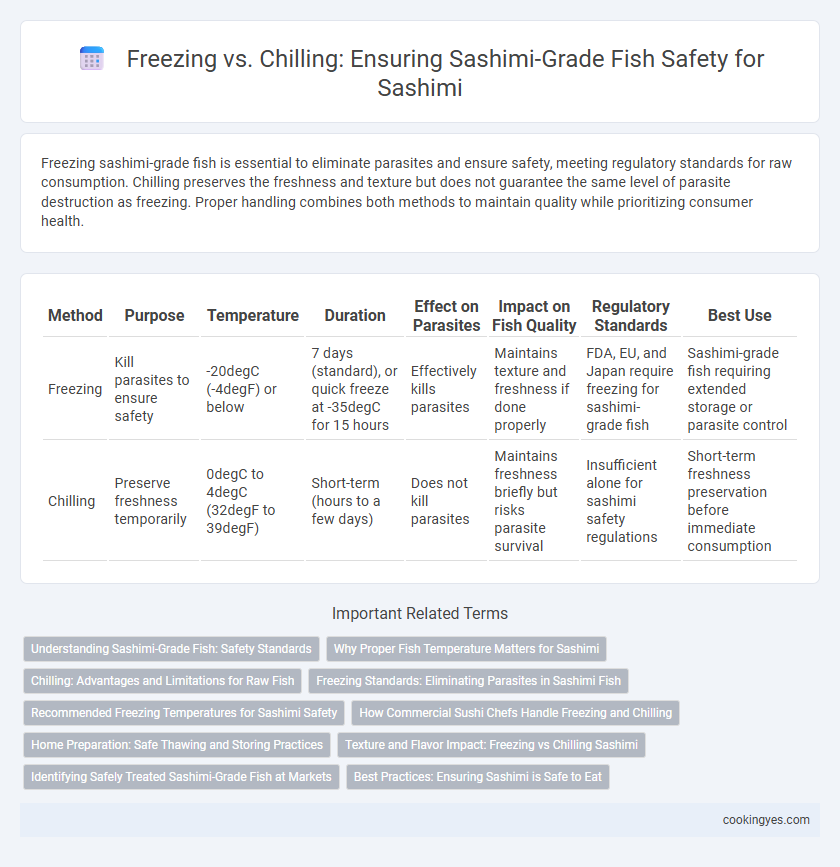Freezing sashimi-grade fish is essential to eliminate parasites and ensure safety, meeting regulatory standards for raw consumption. Chilling preserves the freshness and texture but does not guarantee the same level of parasite destruction as freezing. Proper handling combines both methods to maintain quality while prioritizing consumer health.
Table of Comparison
| Method | Purpose | Temperature | Duration | Effect on Parasites | Impact on Fish Quality | Regulatory Standards | Best Use |
|---|---|---|---|---|---|---|---|
| Freezing | Kill parasites to ensure safety | -20degC (-4degF) or below | 7 days (standard), or quick freeze at -35degC for 15 hours | Effectively kills parasites | Maintains texture and freshness if done properly | FDA, EU, and Japan require freezing for sashimi-grade fish | Sashimi-grade fish requiring extended storage or parasite control |
| Chilling | Preserve freshness temporarily | 0degC to 4degC (32degF to 39degF) | Short-term (hours to a few days) | Does not kill parasites | Maintains freshness briefly but risks parasite survival | Insufficient alone for sashimi safety regulations | Short-term freshness preservation before immediate consumption |
Understanding Sashimi-Grade Fish: Safety Standards
Freezing sashimi-grade fish at temperatures below -20degC (-4degF) for at least 7 days effectively kills parasites, meeting international safety standards such as those set by the FDA and EU regulations. Chilling, typically between 0-4degC (32-39degF), slows bacterial growth but does not eliminate parasites, making freezing essential for ensuring safe raw consumption. Understanding these safety protocols is critical for maintaining the integrity and safety of sashimi-grade fish in culinary practices.
Why Proper Fish Temperature Matters for Sashimi
Maintaining the correct temperature is crucial for sashimi-grade fish to prevent harmful bacterial growth and parasite development, ensuring food safety. Freezing fish at -20degC (-4degF) or below for at least seven days effectively kills parasites, while chilling at just above freezing slows bacterial proliferation but does not eliminate parasites. Proper temperature control preserves the fish's texture, freshness, and flavor, which are essential for the high-quality sashimi experience.
Chilling: Advantages and Limitations for Raw Fish
Chilling sashimi-grade fish preserves freshness by slowing bacterial growth without altering texture or flavor, making it ideal for immediate consumption. However, chilling alone may not eliminate all parasites or pathogens, posing potential health risks if the fish is not sourced from highly controlled environments. Proper temperature control between 0degC and 4degC is crucial to maintain safety and quality during short-term storage.
Freezing Standards: Eliminating Parasites in Sashimi Fish
Freezing standards for sashimi-grade fish require maintaining a temperature of -20degC (-4degF) or lower for at least 7 days to effectively eliminate parasites such as Anisakis and tapeworm larvae. These regulations, established by food safety authorities including the FDA and European Food Safety Authority, ensure parasite destruction while preserving the fish's texture and flavor. Proper freezing protocols are critical in preventing foodborne illnesses and guaranteeing sashimi-grade fish safety before consumption.
Recommended Freezing Temperatures for Sashimi Safety
Sashimi-grade fish safety requires precise freezing temperatures to eliminate parasites and reduce bacterial growth risks. The FDA recommends freezing fish at -20degC (-4degF) or below for at least 7 days, or at -35degC (-31degF) or below for 15 hours for effective parasite destruction. Properly maintained freezing protocols ensure sashimi-grade fish retains optimal texture and flavor while meeting stringent safety standards.
How Commercial Sushi Chefs Handle Freezing and Chilling
Commercial sushi chefs prioritize freezing sashimi-grade fish at ultra-low temperatures, typically -20degC (-4degF) or below for at least seven days, to eliminate parasites and ensure safety. Chilling alone, maintained just above freezing around 0-4degC (32-39degF), preserves freshness but does not reliably kill parasites, making freezing a critical step. Quality control includes rapid freezing techniques like blast freezing that minimize ice crystal formation, maintaining texture and flavor essential for premium sashimi.
Home Preparation: Safe Thawing and Storing Practices
Freezing sashimi-grade fish at -20degC (-4degF) for at least 7 days effectively kills parasites, ensuring safety for consumption. When thawing at home, keep the fish in the refrigerator between 0-4degC (32-39degF) to prevent bacterial growth and maintain texture. Store sashimi fish on ice or in airtight containers to preserve freshness and reduce contamination risks during handling.
Texture and Flavor Impact: Freezing vs Chilling Sashimi
Freezing sashimi-grade fish effectively eliminates parasites while preserving safety, but can slightly alter texture by causing mild cell damage, resulting in a softer, less firm bite compared to chilling. Chilling maintains the fish's natural texture and fresh flavor by keeping muscle fibers intact, yet carries a higher risk of parasite survival if not handled promptly. Optimal sashimi quality balances freezing for safety with precise chilling methods to retain maximum flavor and texture integrity.
Identifying Safely Treated Sashimi-Grade Fish at Markets
Sashimi-grade fish must be properly frozen to eliminate parasites, with FDA regulations recommending freezing at -20degC (-4degF) for at least 7 days or at -35degC (-31degF) for 15 hours, ensuring parasite destruction. Chilling alone does not guarantee the elimination of harmful organisms, making freezing essential for safety. Consumers should verify that sashimi-grade fish at markets bear certifications or labels indicating compliance with these freezing standards to confirm safe treatment.
Best Practices: Ensuring Sashimi is Safe to Eat
Freezing sashimi-grade fish at -20degC (-4degF) or below for at least seven days effectively eliminates parasites, ensuring food safety. Chilling alone, typically at 0-4degC (32-39degF), slows bacterial growth but does not kill parasites or pathogens, making it insufficient as a sole safety measure. Combining strict freezing protocols with proper handling and hygiene practices guarantees sashimi-grade fish remains safe to consume raw.
Freezing vs chilling for sashimi-grade fish safety Infographic

 cookingyes.com
cookingyes.com